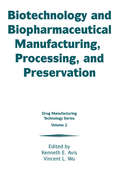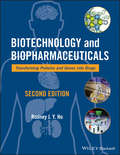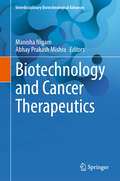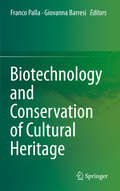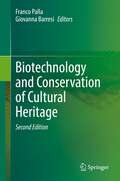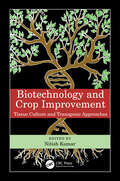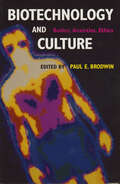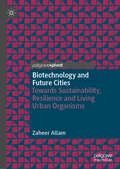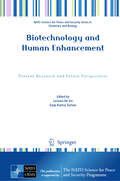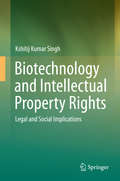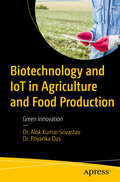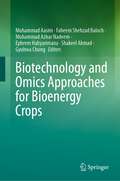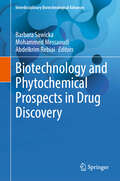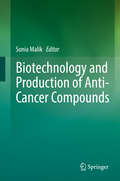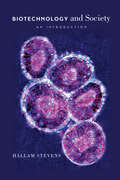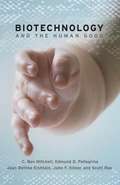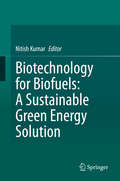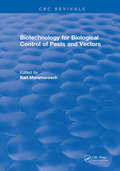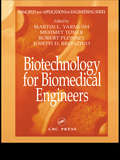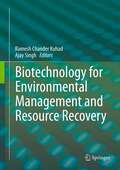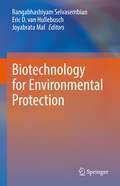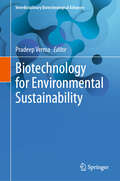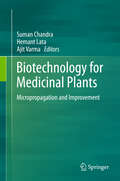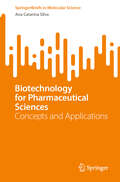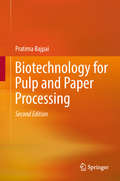- Table View
- List View
Biotechnology and Biopharmaceutical Manufacturing, Processing, and Preservation
by Kenneth E. Avis and Vincent L. WuIn this unique book, experts describe practices applicable to the large-scale processing of biotechnological products. Beginning with processing and bulk storage preservation techniques, the book provides strategies for improving efficiency of process campaigns of multiple products and manufacturing facilities for such processing techniques. Large-scale chromatography for the purification of biomolecules in manufacturing and lyophilization of protein pharmaceuticals are discussed. Includes a case study on blow-fill-seal processing technology and a chapter on economic and cost factors for bioprocess engineering.
Biotechnology and Biopharmaceuticals
by Rodney J. HoBiotechnology and Biopharmaceuticals: Transforming Proteins and Genes into Drugs, Second Edition addresses the pivotal issues relating to translational science, including preclinical and clinical drug development, regulatory science, pharmaco-economics and cost-effectiveness considerations. The new edition also provides an update on new proteins and genetic medicines, the translational and integrated sciences that continue to fuel the innovations in medicine, as well as the new areas of therapeutic development including cancer vaccines, stem cell therapeutics, and cell-based therapies.
Biotechnology and Cancer Therapeutics (Interdisciplinary Biotechnological Advances)
by Abhay Prakash Mishra Manisha NigamThis book explores new ground in the field of cutting-edge cancer treatment modalities by presenting contemporary biotechnological developments as a component of cancer targeting techniques. It addresses the application of modern technologies in cancer detection, targeting, and the development of therapeutic strategies across fifteen comprehensive chapters. The book emphasizes the advantages of molecular techniques for cancer therapies, such as molecular diagnosis, cell and gene therapy, and immunotherapy, with a dedicated chapter on personalized cancer therapy to critically analyze the progression toward precision strategies. The chapters cover topics such as molecular biomarkers, microRNAs, and the potential of nanomedicine in cancer treatment. The authors provide expert analysis on the latest research, offering insights into the outcomes of scientific and clinical trials. Readers will also discover discussions on drug resistance, novel molecular targets, and the integration of biotechnology in drug discovery and development. Particular attention is given to the role of epigenetics and RNA interference in cancer therapy, as well as the challenges and future prospects of personalized medicine. This book is designed specifically for oncologists, cancer biologists, researchers, academicians, and students interested in understanding the most cutting-edge biotechnological aspects of cancer therapeutics. It offers a comprehensive overview of cancer prevention, therapeutics, and treatments through the perspectives of technology, medicine, and alternative therapies. Researchers in the field of biotechnology and cancer therapy will find this book invaluable for its detailed discussions and insights into the latest advancements. It serves as a crucial tool for those working in this area, providing a valuable resource for understanding the complexities of cancer therapies and fostering progress in the field.
Biotechnology and Conservation of Cultural Heritage
by Franco Palla Giovanna BarresiThis book provides detailed insights into the role of microorganisms and microbial products in biodeterioration, conservation and restoration of cultural heritage. Topics to be discussed are microbial colonization and their growth control on both artworks and aerosol of indoor environments such as libraries or museums, as well as human health hazard from exposure to microbial agents. In addition innovative biotechnological protocols and strategies for the removal of undesired layers on artwork surfaces are described in detail. Also the advances and perspectives in this emerging biotechnological field are discussed, supported by the latest original findings.
Biotechnology and Conservation of Cultural Heritage
by Franco Palla Giovanna BarresiThis second fully updated and extended edition of Biotechnology and Conservation of Cultural Heritage provides in-depth insights into the role of different microorganisms and microbial compounds in biodeterioration, conservation and restoration of artworks and artifacts. Latest methods to detect, remove and prevent microbial colonization on artwork surfaces and in air environments of libraries and museums are discussed and illustrated by engaging case studies. Furthermore, this edition covers new case studies on Archaeobiology, exploring ways to perform the molecular biology characterization, restoring and protecting museum taxidermal specimens, preserving and guaranteeing the future integrity. Finally, the use of halloysite-nanotubes is investigated to set up innovative protocols in consolidation and long-term protection of waterlogged and archaeological wood. This book addresses to Biologists, Microbiologists, Conservation Scientists and Conservators who are interested in understanding the role of microorganisms and bioactive molecules in conservation projects.
Biotechnology and Crop Improvement: Tissue Culture and Transgenic Approaches
by Nitish KumarBiotechnology and Crop Improvement The green revolution led to the development of improved varieties of crops, especially cereals, and since then, classical or molecular breeding has resulted in the creation of economically valuable species. Thanks to recent developments in biotechnology, it has become possible to introduce genes from different sources, such as bacteria, fungi, viruses, mice and humans, to plants. This technology has made the scientific community aware of the critical role of transgenic, not only as a means of producing stress tolerant crops but also as a platform for the production of therapeutics through molecular farming. Biotechnology and Crop Improvement: Tissue Culture and Transgenic Approaches focuses on important field crops to highlight germplasm enhancement for developing resistance to newly emerging diseases, pests, nutrient- and water-use efficiency, root traits and improved tolerance to increasing temperature and introduces significant recent achievements in crop improvement using methods such as micropropagation, somaclonal variation, somatic embryogenesis, anther/pollen/embryo culture, and compressing the breeding cycle for accelerated breeding and early release of crop varieties. Plant biotechnology has now become an integral part of tissue culture research. The tremendous impact generated by genetic engineering and consequently of transgenic now allows us to manipulate plant genomes at will. There has indeed been a rapid development in this area with major successes in both developed and developing countries. Development of transgenic crop plants, their utilization for improved agriculture, health, ecology and environment and their socio-political impacts are currently important fields in education, research, and industry and also of interest to policy makers, social activists and regulatory and funding agencies. This work prepared with a class-room approach on this multidisciplinary subject will fill an existing gap and meet the requirements of such a broad section of readers. It describes the recent biotechnological advancement and developments in plant tissue culture and transgenic. Plant tissue culture techniques such as such as micropropagation, regeneration, somaclonal variation, somatic embryogenesis, anther/pollen/embryo culture are discussed for genetic improvement of crop plant. Transgenic techniques are discussed for developing resistance to newly emerging diseases, pests, nutrient- and water-use efficiency, root traits, and improved tolerance to increasing temperature. Key Features Shows the importance of plant tissue culture and transgenic technology on plant biology research and its application to agricultural production Provides insight into what may lie ahead in this rapidly expanding area of plant research and development Contains contributions from major leaders in the field of plant tissue culture and transgenic technology This book is devoted to topics with references at both graduate and postgraduate levels. The book traces the roots of plant biotechnology from the basic sciences to current applications in the biological and agricultural sciences, industry, and medicine. The processes and methods used to genetically engineer plants for agricultural, environmental, and industrial purposes along with bioethical and biosafety issues of the technology are vividly described in the book.
Biotechnology and Culture: Bodies, Anxieties, Ethics
by Paul E. BrodwinEssays on technology’s effect on our relationship with our bodies: “A timely and perceptive look . . . at some of the most anxiety producing issues of the day.” —Paul Rabinow, University of California, BerkeleyAs birth, illness, and death increasingly come under technological control, struggles arise over who should control the body and define its limits and capacities. Biotechnologies turn the traditional “facts of life” into matters of expert judgment and partisan debate. They blur the boundary separating people from machines, male from female, and nature from culture. In these diverse ways, they destroy the “gold standard” of the body, formerly taken for granted.Biotechnologies become a convenient, tangible focus for political contests over the nuclear family, legal and professional authority, and relations between the sexes. Medical interventions also transform intimate personal experience: giving birth, building new families, and surviving serious illness now immerse us in a web of machines, expert authority, and electronic images. We use and imagine the body in radically different ways, and from these emerge new collective discourses of morality and personal identity.This book brings together historians, anthropologists, cultural critics, and feminists to examine the broad cultural effects of technologies such as surrogacy, tissue-culture research, and medical imaging. The moral anxieties raised by biotechnologies and their circulation across class and national boundaries provide other interdisciplinary themes for discourse in these essays. The authors favor complex social dramas of the refusal, celebration, or ambivalent acceptance of new medical procedures. Eschewing polemics or pure theory, contributors show how biotechnology collides with everyday life and reshapes the political and personal meanings of the body.Contributors include Paul Brodwin, Lisa Cartwright, Thomas Csordas, Gillian Goslinga-Roy, Deborah Grayson, Donald Joralemon, Hannah Landecker, Thomas Laqueur, Robert Nelson, Susan Squier, Janelle Taylor, and Alice Wexler.“This impressive collection offers a number of rich examples of why the development of anthropological studies of science, technology, and their disruptive social effects is a leading edge of critical enquiry.” —Arthur Kleinman, Harvard University
Biotechnology and Future Cities: Towards Sustainability, Resilience and Living Urban Organisms
by Zaheer AllamThis book explores how biotechnology can lead to the reimagination of cities. In a time where the increasing adoption of technology by cities is leading to unsustainable environmental and economic concerns, biotechnology has enabled new ways of envisioning data and energy storage. Zaheer Allam thus revisits the popular concept of Smart Cities -and its associated Internet of Things (IoT) to explore how the biological sciences, coupled with technology, can be applied to cities; and in doing so, create living urban organisms on an unprecedented scale. This new concept will open up exciting avenues to providing novel solutions for climate change mitigation. The book goes on to address various potential concerns and discusses what regulatory frameworks would be needed to safely implement such a concept. It will be a useful tool for planners, policy makers and engineers as well as for researchers with in interest in the future of our cities.
Biotechnology and Human Enhancement: Present Research and Future Perspectives (NATO Science for Peace and Security Series A: Chemistry and Biology)
by Eyup Kuntay Turmus Luciano De SioThis book provides new insights in the role that biotechnology and human enhancement will play in the following years to come. Based on the experience and know-how of recognized scientists worldwide, a paradigm shift in advanced technologies is highlighted, merging academic and specialized research centers. Indeed, biotechnology and human enhancement play an essential role in emerging fields such as biosensing, medical technologies, and synthetic biology. These technologies are significant for several cross-disciplinary research activities ranging from medicine to electronics. The book promotes a visionary idea that will establish a more vital collaboration to help track down a roadmap for bringing innovative and breakthrough applications to address the key and emerging challenges for the upcoming years. The book is intended to offer a comprehensive overview for both students and experienced researchers about the main research activities developed in recent years that will help realize a more sustainable approach in modern bio-related applications.
Biotechnology and Intellectual Property Rights: Legal and Social Implications
by Kshitij Kumar SinghThis book offers a valuable contribution to contemporary legal literature, providing deep insights into the interface between law and genetics, highlighting emerging issues and providing meaningful solutions to current problems. It will be of interest to a broad readership, including academics, lawyers, policy makers and scholars engaged in interdisciplinary research. In the context of examining and analyzing the legal and social implications arising from the recent conjunction of biotechnology and intellectual property rights, the book particularly focuses on human genes and gene variations. Emphasis is placed on "patent law," as a considerable percentage of genetic inventions are covered by patents. The book presents a comparative and critical examination of patent laws and practices related to biotechnology patents in the United States, Canada, European Union and India, in order to gather the common issues and the differences between them. The international patent approach regarding biotechnology is also analyzed in light of the constant conflict between differentiation and harmonization of patent laws. The book highlights the potential gaps and uncertainties as to the scope of numerous terms such as invention, microorganisms, microbiological processes, and essential biological processes under TRIPS. Also analyzed are the social and policy implications of patents relating to genetic research tools and genetic testing. The intricacies involved in providing effective intellectual property protection to bioinformatics and genomic databases are also examined. Bearing in mind the collaborative nature of bioinformatics and genomic databases, the book evaluates the pros and cons of open biotechnology and assesses the implications of extending intellectual property rights to human genetic resources, before explaining the ownership puzzle concerning human genetic material used in genetic research.
Biotechnology and IoT in Agriculture and Food Production: Green Innovation
by Dr. Alok Srivastav Dr. Priyanka DasExplore the transformative intersection of biotechnology and the Internet of Things (IoT) in modern agriculture. This book delves into sustainable solutions and cutting-edge technologies that are revolutionizing the global food production industry. The book is structured to provide an in-depth understanding of how green innovation is reshaping agriculture. Starting with an introduction to sustainability in agriculture, it traces the evolution from traditional farming to smart farming methods, where IoT and Biotechnology come together to optimize crop management, soil health, and resource utilization. Key chapters include the role of IoT in precision farming, biotechnology advancements like CRISPR and GMOs, and their integration for improved crop resilience, pest control, and water management. The synergy between IoT's real-time data capabilities and biotechnology's genetic innovations is highlighted in smart greenhouses, vertical farming, and climate-resilient agriculture. Other critical topics include reducing food waste through technology, the role of AI and machine learning in agricultural practices, blockchain for supply chain transparency, and Biotech's impact on livestock management. Ethical considerations, regulatory frameworks, and green finance opportunities are also addressed, alongside future trends like 5G, drones, and synthetic biology. You will gain a comprehensive view of how biotechnology and IoT are driving sustainable agricultural practices, fostering innovation, and offering solutions to global food security challenges. The book offers practical insights into the future of farming and policy recommendations to ensure a sustainable, tech-driven agricultural future. You Will • Learn how data analytics, AI, and biotech innovations work together in precision farming, optimizing resource usage, improving yields, and addressing environmental challenges • Discover innovative solutions for sustainable food production, including smart irrigation systems, IoT-enabled greenhouses, vertical farming, and biotechnological methods for improving soil health and reducing food waste • Understand the ethical concerns, privacy issues, and regulatory frameworks that govern the use of IoT and biotechnology in agriculture Who Is This Book For Readers with a foundational understanding of agriculture, technology, or sustainability, though no specialized expertise is required. Beginners with an interest in how technology is reshaping food production can grasp the concepts, as the book breaks down complex topics into accessible language. A basic familiarity with IoT and biotech will enhance the learning experience but is not essential for following the book&’s key ideas.
Biotechnology and Omics Approaches for Bioenergy Crops
by Shakeel Ahmad Ephrem Habyarimana Gyuhwa Chung Faheem Shehzad Baloch Muhammad Azhar Nadeem Muhammad AasimThis edited book summarizes the efforts made to develop sustainable bioenergy production through different generations. The topics included in the book cover information about different bioenergy crops, their classification and use as biofuel, agronomic practices to improve biomass yield, classic breeding techniques, genetic diversity, current status and future perspective of bioenergy crops in the omics era. It also discusses application of modern biotechnological and molecular biotechnological techniques for the improvement of bioenergy crops this having enhanced biomass and plant based products. The book explores growing biofuel crops and their impact on environment, bioethics and biosafety issues related to the modern approaches. Another important aspect is the incorporation of nanotechnology for bioenergy crops and biofuel production. All book chapters are contributed renowned researchers in their respective field. This is a unique book covering the bioeneragy crops in the modern omics era. The book is useful for the researchers and post-graduate students to guide them in the field of bioenergy crops.
Biotechnology and Phytochemical Prospects in Drug Discovery (Interdisciplinary Biotechnological Advances)
by Barbara Sawicka Mohammed Messaoudi Abdelkrim RebiaiThis book is a comprehensive exploration of the multifaceted role of phytochemicals in contemporary drug discovery and biotechnology. Comprising eleven insightful chapters, it navigates through the historical roots, current applications, and future possibilities of harnessing plant-derived compounds for medicinal advancements. The initial chapters introduce phytochemicals and their historical significance in traditional medicine, highlighting the scientific validation offered by phytochemistry and pharmacology. The subsequent chapters delve into the incorporation of biotechnology into phytochemical synthesis, focusing on metabolic engineering, synthetic biology, and plant tissue culture to enhance efficiency and reduce environmental impact. The integration of nanomaterial synthesis with medicinal plant extracts is explored for its potential in biomedical applications, such as targeted drug delivery. A thorough examination of bioactive properties of secondary metabolites in unripe fruit extracts reveals their role in immune enhancement, alongside factors affecting bioactive compound content. Advanced analytical techniques crucial to drug discovery are discussed, including "green extraction" and modern methods like high-performance liquid chromatography (HPLC) and gas chromatography (GC) for phytochemical purification and identification. The COVID-19 pandemic has highlighted challenges and strategies in drug discovery, with computational biology advancing molecular target identification and innovative screening methodologies. The exploration of mineral profiling in medicinal plants underscores its importance for human health, detailing methods to identify essential and harmful elements, and noting the nutritional value of these plants. The penultimate chapter addresses future opportunities and challenges in using medicinal plants for drug development, spotlighting India's contributions to global pharmaceutical needs. The final chapter examines phytochemicals as alternative therapeutics against SARS-CoV-2, highlighting antiviral properties and the novel concept of molecular plant farming for vaccine development. This book is a comprehensive resource for those interested in phytochemistry, biotechnology, and pharmacology, elucidating the role of plant-derived chemicals in contemporary medicine and technology.
Biotechnology and Production of Anti-Cancer Compounds
by Sonia MalikThis book discusses cancers and the resurgence of public interest in plant-based and herbal drugs. It also describes ways of obtaining anti-cancer drugs from plants and improving their production using biotechnological techniques. It presents methods such as cell culture, shoot and root culture, hairy root culture, purification of plant raw materials, genetic engineering, optimization of culture conditions as well as metabolic engineering with examples of successes like taxol, shikonin, ingenol mebutate and podophylotoxin. In addition, it describes the applications and limitations of large-scale production of anti-cancer compounds using biotechnological means. Lastly, it discusses future economical and eco-friendly strategies for obtaining anti-cancer compounds using biotechnology.
Biotechnology and Society: An Introduction
by Hallam StevensWith Biotechnology and Society, Hallam Stevens offers an up-to-date primer to help us understand the interactions of biotechnology and society and the debates, controversies, fears, and hopes that have shaped how we think about bodies, organisms, and life in the twenty-first century. Stevens addresses such topics as genetically modified foods, cloning, and stem cells; genetic testing and the potential for discrimination; fears of (and, in some cases, hopes for) designer babies; personal genomics; biosecurity; and biotech art. Taken as a whole, the book presents a clear, authoritative picture of the relationship between biotechnology and society today, and how our conceptions (and misconceptions) of it could shape future developments. It is an essential volume for students and scholars working with biotechnology, while still being accessible to the general reader interested in the truth behind breathless media accounts about biotech’s promise and perils.
Biotechnology and the Human Good
by Jean Bethke Elshtain Scott B. Rae C. Ben Mitchell Edmund D. Pellegrino John F. KilnerSome of humankind's greatest tools have been forged in the research laboratory. Who could argue that medical advances like antibiotics, blood transfusions, and pacemakers have not improved the quality of people's lives? But with each new technological breakthrough there comes an array of consequences, at once predicted and unpredictable, beneficial and hazardous. Outcry over recent developments in the reproductive and genetic sciences has revealed deep fissures in society's perception of biotechnical progress. Many are concerned that reckless technological development, driven by consumerist impulses and greedy entrepreneurialism, has the potential to radically shift the human condition -- and not for the greater good. Biotechnology and the Human Good builds a case for a stewardship deeply rooted in Judeo-Christian theism to responsibly interpret and assess new technologies in a way that answers this concern. The authors jointly recognize humans not as autonomous beings but as ones accountable to each other, to the world they live in, and to God. They argue that to question and critique how fields like cybernetics, nanotechnology, and genetics might affect our future is not anti-science, anti-industry, or anti-progress, but rather a way to promote human flourishing, common sense, and good stewardship. A synthetic work drawing on the thought of a physician, ethicists, and a theologian, Biotechnology and the Human Good reminds us that although technology is a powerful and often awe-inspiring tool, it is what lies in the heart and soul of who wields this tool that truly makes the difference in our world.
Biotechnology for Biofuels: A Sustainable Green Energy Solution
by Nitish KumarThe depletion of petroleum-derived fuel and environmental concerns have prompted many millennials to consider biofuels as alternative fuel sources. But completely replacing petroleum-derived fuels with biofuels is currently impossible in terms of production capacity and engine compatibility. Nevertheless, the marginal replacement of diesel with biofuel could delay the depletion of petroleum resources and abate the radical climate change caused by automotive pollutants. Energy security and climate change are the two major driving forces for worldwide biofuel development, and also have the potential to stimulate the agro-industry. The development of biofuels as alternative and renewable sources of energy has become critical in national efforts towards maximum self-reliance, the cornerstone of our energy security strategy. At the same time, the production of biofuels from various types of biomass such as plants, microbes, algae and fungi is now an ecologically viable and sustainable option. This book describes the biotechnological advances in biofuel production from various sources, while also providing essential information on the genetic improvement of biofuel sources at both the conventional and genomic level. These innovations and the corresponding methodologies are explained in detail.
Biotechnology for Biological Control of Pests and Vectors
by Karl MaramoroschThis book describes new strategies being used to combat disease agents and invertebrate pests. Outstanding experts from the United States, Belgium, China, Guatemala, Japan, Philippines, Singapore, and Thailand have contributed chapters that cover the latest achievements in genetic engineering, emphasizing the microbial and viral biological control agents that can provide environmentally safe, economical control systems. Topics discussed include genetic engineering of Bacillus thuringiensis and B. sphaericus, the development of insect resistance to microbial biocontrol agents, engineering of baculoviruses and nematodes, bioengineering of plants, plant transformation by particle bombardment, fusion of cultured insect cells, new immunodiagnostic assays and control measures against parasitic human diseases, and genetically engineered microbial agents for malaria control. The book also presents improved mass production procedures of microbial and viral biocontrol agents, as well as regulatory and environmental aspects of genetically engineered biocontrol agents. Biotechnology for Biological Control of Pests and Vectors will provide a valuable reference for researchers and students of biological control, microbiology, virology, and molecular biology.
Biotechnology for Biomedical Engineers (Principles and Applications in Engineering)
by Martin L. Yarmush Joseph D. Bronzino Mehmet Toner Robert PlonseyWith the advent of recombinant DNA technology, monoclonal antibody technology, and new technologies for studying and handling cells and tissues, the field of biotechnology has undergone a tremendous resurgence in a wide range of applications pertinent to industry, medicine, and science in general. A volume in the Principles and Applications in Engi
Biotechnology for Environmental Management and Resource Recovery
by Ajay Singh Ramesh Chander KuhadVarious types of secondary agriculture and forestry wastes represent valuable resource materials for developing alternate energy as biofuels and other value added products such as sugars, phenols, furans, organic acids, enzymes and digestible animal feed etc. However, if not managed properly, waste material and environmental contaminants generated by various industries such as food and feed, pulp and paper and textile may lead to severe environmental pollution. The energy, food and feed demand necessitate developing simple and economically viable technologies for environmental management and resource recovery. Microorganisms and their enzymes contribute significantly in utilization of plant residues, resource recovery and eventually in pollution mitigation. "Biotechnology for Environmental Management and Resource Recovery" presents a comprehensive review of selected research topics in a compendium of 16 chapters related to environmental pollution control and developing biotechnologies in agro-ecosystem management and bioconversion of agro-residues (lignocellulosics) into biofuels, animal feed and paper etc. This book provides a valuable resource for reference and text material to graduate and postgraduate students, researchers, scientists working in the area of microbiology, biotechnology, and environmental science and engineering.
Biotechnology for Environmental Protection
by Joyabrata Mal Eric D. van Hullebusch Rangabhashiyam SelvasembianThis book covers broader application of biotechnology for the protection of environment through different bioremediation and biodegradation techniques developed for removal of environmental contaminants including the recently discovered contaminants. The book offers a comprehensive overview of environmental pollutants including their fate, behavior, environmental and associated health risks. It is useful reading material for postgraduate and graduate students of environmental biotechnology, environmental microbiology and ecology. Young researchers also find the chapters useful understanding the latest developments.
Biotechnology for Environmental Sustainability (Interdisciplinary Biotechnological Advances)
by Pradeep VermaThis book covers the broader application of environmental biotechnology for protecting the environment through different bioremediation and biodegradation techniques framed toward removing environmental contaminants, including emerging contaminants. The extensive range of environmental pollutants, which may be organic or inorganic, including toxic heavy metals, radionuclides, synthetic organic dyes, organic compounds, endocrine-disrupting chemicals, pharmaceuticals, and personal care products, etc., continue to pose a threat to human health and ecosystem functioning. The book covers a comprehensive overview of environmental pollutants, including their fate, behavior, and environmental and health risks associated with them. It describes the utilization of bioremediation and phytoremediation processes to provide a superior alternative removal and detoxification of such toxic environmental pollutants directed toward managing ecosystems. It includes an overview of gene modification and omics technology for environment management for the aesthetic approaches to environmental clean-up. Moreover, the book discusses resource recovery from waste using such technologies, which increases the feasibility of the process. Additionally, the book is designed to provide awareness among its readers about major environmental issues like pollution and its management and control through biotechnological means to promote the sustainable development of our society with minimal environmental impact. It also provides technical content regarding the mechanism of bioremediation, biodegradation, and phytoremediation and their field applicability, along with an overview of emerging pollutants and gene modification techniques for remediation applications.
Biotechnology for Medicinal Plants: Micropropagation and Improvement
by Ajit Varma Suman Chandra Hemant LataPlant-based medicines play an important role in all cultures, and have been indispensable in maintaining health and combating diseases. The identification of active principles and their molecular targets from traditional medicine provides an enormous opportunity for drug development. Using modern biotechnology, plants with specific chemical compositions can be mass propagated and genetically improved for the extraction of bulk active pharmaceuticals. Although there has been significant progress in the use of biotechnology, using tissue cultures and genetic transformation to investigate and alter pathways for the biosynthesis of target metabolites, there are many challenges involved in bringing plants from the laboratory to successful commercial cultivation. This book presents the latest advances in the development of medicinal drugs, including topics such as plant tissue cultures, secondary metabolite production, metabolomics, metabolic engineering, bioinformatics and future biotechnological directions.
Biotechnology for Pharmaceutical Sciences: Concepts and Applications (SpringerBriefs in Molecular Science)
by Ana Catarina SilvaThis book provides a compact and straightforward overview of the main concepts and applications of Pharmaceutical Biotechnology. The author collates lecture notes on Pharmaceutical Biotechnology to introduce the topic to graduate students in the fields of Pharmaceutical Sciences, Biochemistry, Biotechnology and Industrial Biotechnology, Microbiology, and Medicinal Chemistry. The book starts with an overview of the biotechnological processes needed to develop biological and biosimilar medicines. Next, the author addresses the development and use of advanced therapy medicinal products (ATMPs), including topics such as cell and gene therapies, regenerative medicine and the regulatory issues of biological medicines and ATMPs. Finally, the author explores the limitations of administering biopharmaceuticals, discussing protein and nucleic acid stability issues, potential routes of administration and strategies for improving the bioavailability of biologics and ATMPs. This book captures the latest developments in the field and offers a practical perspective on the topic, serving as a valuable introduction resource not only for graduate students but also for researchers. The basis of the English translation of this book, originally in Portuguese, was facilitated by artificial intelligence. The content was later revised by the author for accuracy.
Biotechnology for Pulp and Paper Processing
by Pratima BajpaiThe book provides the most up-to-date information available on various biotechnological processes useful in the pulp and paper industry. The first edition was published in 2011, covering a specific biotechnological process or technique, discussing the advantages, limitations, and prospects of the most important and popular processes used in the industry. Many new developments have taken place in the last five years, warranting a second edition on this topic. The new edition contains about 35% new material covering topics in Laccase application in fibreboard; biotechnology in forestry; pectinases in papermaking; stickies control with pectinase; products from hemicelluloses; value added products from biorefinery lignin; use of enzymes in mechanical pulping.
